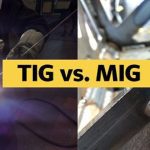Part of what makes aluminum great is that it is so lightweight. It is also an incredibly sensitive metal. Being naturally more porous, the metal is more subject to contamination during welding. Since it is more sensitive, it also is subject to heat distortion. Check out some of these aluminum welding projects and admire the overall craftsmanship required to work with this metal. Perhaps you might find you want to try your hand at one.
The 14 Aluminum Welding Project Are:
1. Battery Tray
| Materials: | 1/8” Aluminum plate, 6” turnbuckles |
| Tools: | Welder, grinder, angle iron or sheet metal bender, hammer (optional) |
| Difficulty: | Moderate |
Watch how the designer builds a battery tray for his truck. He removes the battery, makes paper templates based on the dimensions of the previous tray, and then adds a little wiggle room. He then transfers the template pattern onto an aluminum sheet and cuts the pieces. You will have to measure your own dimensions. Once the pieces are cut, they are tacked and welded together. You’ll see that he changed the design slightly to add two mounting brackets with holes instead of two holes directly on the tray.
2. Starting Blocks
| Materials: | Aluminum sheet |
| Tools: | Sheet metal bender, saw, welder, grinder |
| Difficulty: | Moderate |
If your kids are learning to ride motorcycles/dirt bikes, but their feet can’t quite give them the push-off that they need, consider making these starting blocks from aluminum. The bent shape is made with a sheet metal bender, but you could bend it using a piece of an angle iron or vise if you have to. Then, the side pieces are traced based on the bent piece. Tack it together, weld it up, and get ready to ride!
3. Scab Patch
| Materials: | Aluminum |
| Tools: | Welder, grinder |
| Difficulty: | Easy |
Since aluminum melts much quicker than many other metals, including steel, repairing it is especially challenging. Aluminum is more prone to damage, such as holes caused by excess oxidization or punctures. This is not a project you build from scrap, but it is essential to know how to repair aluminum if you are going to work on it. Before you weld your part, you want to ensure that your material is clean. Wipe it down with acetone and let it dry. You can also use the natural cleaning action of the alternating current on your TIG machine to help prep the metal before you start. When grinding on aluminum, it’s best to use a flapper wheel with beeswax to soften the effect. Once you’ve made the initial repair of fixing a hole, you can then add a doubler, which is another piece of aluminum over the top for extra protection.
4. Tool Storage Unit
| Materials: | Aluminum sheet |
| Tools: | Welder, grinder |
| Difficulty: | Easy |
This design is pretty simple. It’s five pieces of aluminum that form the base and walls of this little box. The tall wall has an additional piece that acts as a little lip so you can hang it on the end of your workbench. If you wanted to make it a little sleeker looking, you could make the bottom part of the tray as well as the front and back out of one piece and bend it in a sheet metal bender. This way, you won’t have to worry about as much heat distortion or spending more time welding.
5. Bonsai Planter
| Materials: | ¼” Aluminum plate |
| Tools: | Welder, Grinder, saw, drill |
| Difficulty: | Moderate |
Some bonsai trees can be grown for decades, but you will have to maintain them at some point. Since they are particularly fragile at times, an aluminum planter is a great option. You won’t have to transfer it because the planter won’t deteriorate like a wooden one. The base is a hexagonal plate with walls on all sides, and all the welds are outside corner joint welds. Once you’ve welded it up, center punch and drill holes on the bottom for drainage.
6. Coin Bank
| Materials: | Aluminum sheet |
| Tools: | Saw, jigsaw, drill, tap, welder |
| Difficulty: | Moderate |
Apparently, outside corner joints are the thing to do when welding TIG. It’s probably because if you can weld it the right way, those dimes stacked on the corners look awesome. The fabricator in this video made this coin bank for his kid. Six pieces of aluminum sheet are cut out to make the cube. The top piece has a slot cut out to place coins, and the bottom piece has a larger slot from where you can empty it.
This bottom piece has two other tabs welded inside the larger hole. A door to the bank is attached by a drilled and tapped hole on one of the tabs. A cool trick for cutting holes in the middle of a plate is to drill holes at the corners and then use a jigsaw.
7. Dog Pot Planter
| Materials: | Aluminum sheet |
| Tools: | Saw, welder, grinder, bender |
| Difficulty: | Difficult |
Since the parts of this dog pot planter are drawn on paper and then afterward transferred onto the sheet, feel free to make one based on whichever dog breed you see fit. As for the planter holder, you can measure it based on the circumference of the pot. Then transfer the measurements to your sheet. Cut out the pieces with a saw, tack them up, and weld them together with TIG.
8. Bicycle Frames
| Materials: | Aluminum tubing |
| Tools: | Welder, grinder, saw |
| Difficulty: | Difficult |
There’s a reason we buy our bikes from a shop. That’s because the frames are challenging to build for most people. It takes skilled fabricators with special sets of tools to make all the right cuts. Now, cutting and coping pipe is possible without a coping machine. Check out this tube and notching calculator. You can measure it out manually and cut it with a torch or saw. Once you have it all fit up, you will need to TIG weld it.
9. Pumpkin
| Materials: | Aluminum tubing, hex stock |
| Tools: | Saw, calipers, welder, grinder, drill, lathe |
| Difficulty: | Difficult |
Measure out 10 equal lengths on a piece of aluminum tubing. Then cut them at an angle on a bandsaw between each section, leaving about ¼” landing. These small ¼” landings will be the point at which you tack them together. Once you’ve cleaned up your pieces after cutting, tack them together in pairs. Then tack the pairs side by side until you’ve completed your overall pumpkin shape and weld all the seams. Then, machine a piece of hex stock in the lathe so that it is more rounded on the bottom. This will become the stem. You can also twist some filler wire for added twigs on the top of your pumpkin. If you drill a hole in your stem, you can fill the pumpkin with solvent and heat it from the bottom. Be sure to watch until the end!
10. Ball
| Materials: | 1/8” Aluminum sheet |
| Tools: | Baseball, sheet metal roller, vise, welder, grinder |
| Difficulty: | Moderate |
In this project, you will cut through the seams around both horseshoes of the baseball. Then, remove one of the leather pieces and trace it twice on a piece of paper. This will become your template. Be sure to use only one to ensure that it’s symmetrical. Not all baseballs are created symmetrically with the leather. Plus, the stitching helps even out any discrepancies. Trace your pattern onto an aluminum sheet. Once you’ve cut out both pieces, clean them up and run them through the sheet metal roller. Then, taking one of them at a time, place the piece around the remaining cork and string core of the baseball in the vise, and squeeze it until it fits nicely around the ball. Fit it together and weld it up. As you are tacking it, you will likely need to keep adjusting the fit-up with a hammer.
11. TIG Pyramid
| Materials: | 1/8” Aluminum plate |
| Tools: | Welder, grinder |
| Difficulty: | Moderate |
Check out this “super cool, random weld joint,” as the fabricator himself calls it! It’s basically a bunch of triangles tacked and welded together. The welds are mostly outside corner joints. The only tee joint welds are where the pyramids connect to each other and the base plate. This is more of an art piece so if you have a slightly different design in mind, go for it!
12. Soda Cans
| Materials: | Soda/beer cans |
| Tools: | TIG welder |
| Difficulty: | Moderate |
While we’re on the subject of pyramids, if you’re the kind of person that likes to build pyramids out of beer or soda cans, this one is for you. You will need a relatively low amperage to avoid burning through the aluminum of the cans. To make the welding a bit easier, try using a rotary welding positioner so you can simply dab the puddle with your filler rod without moving too much. This will help your welds be much prettier and more consistent. The welds result in cans stacked directly on top of each other, but you could make a pyramid and weld only part of the way around the circumference of the can.
13. Battery Toolbox
| Materials: | Aluminum diamond plate, aluminum angle, weather strip, |
| Tools: | Saw, grinder |
| Difficulty: | Moderate |
For this toolbox project, you’ll cut a base plate using the dimensions of your trailer. Then, take a longer diamond plate and align it with the short side of the trapezoidal base plate. Score the long piece of diamond plate where it meets the ends of the shorter dimension. Then take your grinder with a cut-off wheel and cut partially into the plate. This will allow it to bend easier. Once you’ve bent these, take your next dimension. Once you’ve fit your wall to the base plate, weld them together.
When it comes to the open seam on the walls, use an extra piece of aluminum to help close the gap. For the lid, apply the same principles of bending over the dimensions of the box. You can add an aluminum angle for extra reinforcement on the box and the lid. All that’s left is to install the weather stripping, handle, and hinges!
14. Chain Cover for Snowmobile
| Materials: | 1/8” Aluminum plate |
| Tools: | Welder, grinder, hammer, bender |
| Difficulty: | Moderate |
To make this chain cover, trace the shape of your original chain cover onto your plate. You will need to do this for both dimensions. Then, bend one of the plates to get it around the chain. Other than that, it’s pretty simple. When you are TIG welding, just be sure you are welding with a better torch angle than the one in the video. A little bit more vertical is better than horizontal.
Conclusion
You’ll notice when looking at these demonstration videos that there are a lot of grinders, sanders, and files. However, if you are working with aluminum, it is a good idea to have dedicated pieces of equipment just for aluminum. Cross-contamination of metals can occur and damage the soft aluminum. This doesn’t mean you need a whole new grinder for aluminum but be sure to change out the grinding wheels.









